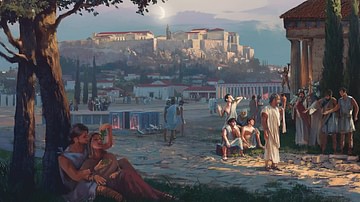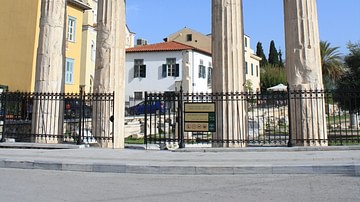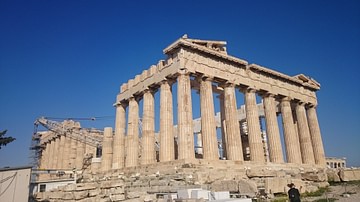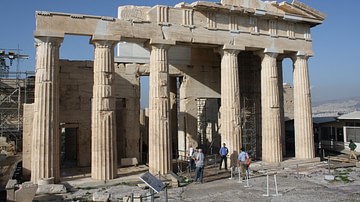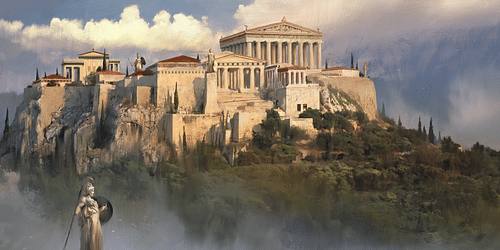
An acropolis is any citadel or complex built on a high hill. The name derives from the Greek akro, "high" or "extreme/extremity" or "edge", and polis, "city", translated as "high city", "city on the edge" or "city in the air", the most famous being the Acropolis of Athens, Greece, built in the 5th century BCE.
Though the word is Greek in origin, it has come to designate any such structure built on a high elevation anywhere in the world. The Castle Rock in Edinburgh, Scotland, for example, fortified as early as 850 BCE, would be considered an acropolis, as would be those cities of the Maya Civilization which fit that definition, even if they were not built on a natural elevation, but one made by human hands. This same model would apply to the Native American cities of North America and their great mounds such as those at Cahokia or Poverty Point which had temples and residences built on hand-packed elevated ground.
Although there were other city-states in ancient Greece boasting an impressive acropolis (such as Thebes, Corinth and, most notably, at Kolona on the Island of Aegina), and the designation acropolis was also used in ancient Rome for a series of buildings set on a higher elevation than the surrounding area, in modern times the word acropolis is synonymous with the ancient site at Athens.
Mycenaean Acropolis
Evidence of human habitation on the Athenian Acropolis dates to the Neolithic Period but the development of the site and the surrounding area begins with the Mycenean Civilization (c. 1700-1100 BCE). The Acropolis rises 490 feet (150 m) above the surrounding area that would become Athens and has a surface area of approximately 7 acres (3 ha) and so was a natural choice for a fortification. The Mycenaeans had fully established themselves by c. 1400 BCE through a fortress and palace on the Acropolis with smaller buildings below in what would become the agora of Athens and monumental tholos (beehive-shaped) tombs (of which over 50 have been excavated in the area). The Mycenaean culture was highly developed and Mycenaean society was hierarchical with a king at the top followed by nobles, warriors, priests, and common people. Scholar Robin Waterfield comments:
The king of a Mycenaean community was simultaneously the political and religious leader of his people and the CEO of a commercial enterprise. The palace complex, though nowhere near the scale of the Minoan palaces on Crete, contained rooms for the storage and inventorying of goods as well as rooms for bathing and dining and audiences with the king. There was a degree of specialized literacy, with scribes recording on clay tablets in the early Greek script called Linear B the king’s possessions and various other commercial or religious transactions. Mycenean economy was redistributive, like that of New Kingdom Egypt: all produce belonged to the king and was gathered into the palace before being redistributed to his subjects according to their status and needs. (37)
The Acropolis, then, served the same purpose for the Mycenaeans as it would later in the Archaic Period (8th century - c. 480 BCE) as the residence of the king, storehouse, and treasury. It was also the site of at least one temple to a female deity (possibly Athena) which featured a sacrificial well or pit offerings were thrown into. The Mycenaean Civilization declined c. 1100 BCE during the period known as the Bronze Age Collapse, but their culture was preserved in the works of the Greek poets Hesiod (l. 8th century BCE) and Homer (l. 8th century BCE), especially in the latter’s Iliad and Odyssey. The Athenians would later claim for themselves a special status as their city was associated with the culture of great heroes like Achilles and Odysseus and, although there were other city-states throughout Greece which could claim the same, none had the impressive height of the Acropolis with the Cyclopean Walls of the Myceneans still in place.
Archaic Acropolis
The agora was a residential district with a central marketplace by the 6th century BCE while the Acropolis continued to serve a religious and political purpose. By this time, Athena was already acknowledged as the patron deity of the city and the myth of how she won that honor was well known. According to the tale, the early king Cecrops wanted the city named for himself, but it was so beautiful that the gods felt it deserved an immortal name. Athena and Poseidon contended for who would have the honor and presented the people with gifts. Poseidon struck a rock on the Acropolis and brought forth water so the people would never have to suffer drought while Athena dropped a seed into the Acropolis’ earth which swiftly grew into an olive tree. Recognizing the many uses and worth of the olive tree, Athena was chosen as the city’s patron.
A temple was built in her honor at the site of the earlier temple on the southwest bastion of the Acropolis using the same building technique of Cyclopean Walls used by the Mycenaeans. By this time, the lawgiver Solon (l. c. 630 - c. 560 BCE) had instituted his laws and trade flourished through the nearby port of Piraeus when the tyrant Peisistratus (d. c. 528 BCE) seized power. The term tyrant should not be understood in its modern sense as it only meant someone who governed according to their own rules and recognized only their own authority.
Peisistratus renovated and improved the agora and had the sacred road of the Panathenaic Way built from the Dipylon Gate of the city up to the Acropolis which would be used annually during the Lesser Panathenaic Festival and every four years in the Greater Panathenaic Festival honoring Athena. The Acropolis at this time was already devoted to her veneration although it is unclear how many temples were there or what they looked like.
Peisistratus was succeeded by his sons Hippias (r. c. 528-510 BCE) and Hipparchus (r. c. 528-514 BCE) who continued his policies. Hipparchus was assassinated in 514 BCE over a personal insult to a young man’s sister and Hippias was overthrown in a coup, supported and essentially accomplished by the Spartans, in 510 BCE. Afterwards, the democratic principles first suggested by Solon were developed by Cleisthenes (l. 6th century BCE) and Athenian democracy was established. The Athenians, who already held a high opinion of themselves, and now believing they had the best government, felt they should help others achieve the same elevated state and so supported the Ionian Greeks of Asia Minor in their revolt against the Persian Empire which controlled them.

Darius I (the Great, r. 522-486 BCE) of the Persian Achaemenid Empire quickly crushed the revolt and then invaded Greece to punish Athens for its arrogance. He was defeated at the Battle of Marathon in 490 BCE by an Athenian force and was planning a second assault when he died and was succeeded by his son Xerxes I (r. 486-465 BCE), who assembled a much larger army and invaded in 480 BCE. Xerxes I burned Athens and destroyed the buildings and temples of the Acropolis and agora before he was defeated and driven from Greece in 479 BCE.
Classical Acropolis
Afterwards, reconstruction of the Acropolis was begun under the guidance of the great general and statesman Pericles of Athens (l. 495 - 429 BCE). Although ancient writers criticized the Athenians for taking so long to begin the restoration of their city, there was a significant amount of work that had to go into clearing the wreckage and then procuring funds for rebuilding. Over two years of detailed planning went into the specifications and contracting the labor for the Parthenon alone, and the first stone was laid on 28 July 447 BCE, during the Panathenaic Festival.
Wishing to create a lasting monument which would honor Athena, celebrate Athenian freedom, and proclaim the glory of the city’s victory over the Persians to the world, Pericles spared no expense in the construction of the Acropolis and, especially, the Parthenon, hiring the skilled architects Callicrates, Mnesikles, and Iktinos, and the sculptor Phidias (recognized as the finest sculptor in the ancient world who created the Statue of Zeus at Olympia, one of The Seven Wonders of the Ancient World) to work on the project.
According to the scholar and art historian John Griffiths Pedley, "the work…was carried out under the supervision of Phidias. In fact, Plutarch says that Phidias was in charge of the whole of Pericles' scheme" (251). This "scheme" was an ambitious building program which drew on ancient building techniques while making use of many innovations. Hundreds of artisans, metalworkers, craftspeople, painters, woodcarvers, and literally thousands of unskilled laborers worked on the Acropolis. The temples were constructed of Pentelic marble quarried from Mount Pentelicus northeast of the city. The blocks had to be cut and transported miles and then brought uphill hundreds of feet to be shaped and fit.

The central temple, and still the most famous, was the Parthenon, dedicated to Athena in her role as the sacred virgin (Athena Parthenos = "Athena the Virgin"). The temple was completely innovative, combining Doric and Ionic architectural styles and using new techniques in fashioning and erecting the columns so they lean slightly inwards, while appearing to stand straight, to give added support to the roof and the illusion of weightlessness in their graceful lines. At the top of the temple were 92 metopes in high relief and a frieze ran around all four sides with lion-headed drain spouts on the four corners. Pedley writes:
The Parthenon is unusual for its mass of Doric refinements…Though these modifications to the horizontal and vertical are miniscule, there are nevertheless no true verticals or horizontals in the building, and hence no right angles. At the same time, these refinements impart a sense of mobility to 'straight' lines and avoid a boxlike appearance. Dignity of form was thus enhanced by dynamism of forms. The demands on the masons were enormous. All blocks, whether curving or not, had to fit flush; yet everywhere block fits meticulously with block, and only on one or two metopes does the carving betray signs of uncertainty or haste. Precisely proportioned, marvelously constructed without mortar or concrete, held together by iron clamps coated with lead to withstand corrosion, this magnificent structure haunts us today with its astonishing blend of technical know-how and grandeur. (253)
The great doors of the temple were wrought in gold, bronze, and ivory and opened onto a large room where the colossal statue of Athena stood almost forty feet (12 m) high and behind the statue was a smaller room, which served as the city’s treasury. Phidias created the statue of gold and ivory around a wooden center. The geographer and historian Pausanias (l. 110-180 CE) describes how it looked in his day:
The cult statue is made of ivory and gold. In the middle of its helmet is a sphinx and on either side of the helmet are carved griffins. The statue of Athena stands upright in an ankle-length robe and on its breast is an ivory representation of the Gorgon Medusa. Athena holds in one of hands a Victory [Nike] and in the other a spear. At her feet lies a shield and, by the spear, a snake which might be Erichthonius. (Greece, 1.24.5-7; Waterfield, 95)

Erichthonius was a legendary king of Athens born of the earth and honored in another famous shrine on the Acropolis, the Erechtheion, dedicated to both Athena and Poseidon, in honor of their gifts to the city, as well as the great king who was thought to be buried near its location. Plans for the Erechtheion were no doubt in place about the same time as those for the Parthenon, and Phidias was commissioned as lead sculptor on the project, but work on the Acropolis overall was interrupted by the Plague at Athens, 430-427 BCE, which took many in the city, including Pericles. Construction on the Erechtheion was held up until c. 421 BCE, and it was completed in 406 BCE.
The Erechtheion is the second most recognizable temple of the complex owing to its Porch of the Maidens, six caryatids (female figures) which serve as the supporting columns. During the Lesser Panathenaic Festival, celebrants would carry a new robe (a peplos) to the wooden cult statue of Athena housed in the Erechtheion while, during the Greater Panathenaic Festival, every four years, a much larger garment was woven by the women of Athena's cult for the statue in the Parthenon.
The Acropolis complex was entered through a monumental Doric gate, the Propylaia, which was developed from the earlier gateway constructed under Peisistratus and flanked by a large, monumental pedestal to the left as one entered and, on the right, by the small Temple of Athena Nike built between c. 427-420 BCE on the site of the earlier Archaic era temple. This was the smallest temple on the Acropolis but one of the most impressive as it was surrounded by a 3-foot high (1 m) parapet on three sides decorated with ornately carved reliefs of Athena and Nike, the goddess of victory, and dedicated to Athena as victor and protector of Athens. A wooden statue of Athena Nike stood in the temple which differed from those of Athena Polias (“Athena of the City”) found on the Acropolis and elsewhere as it was more modest, matching the tone of the building.

Passing through the Propylaia, visitors would have been met by the enormous statue of Athena Promachos ("Athena who fights from the front") which rose 30 feet (9 m) high from a 4-foot (1.5 m) pedestal. This statue also celebrated Athena’s protective role but emphasized her importance as military role model and inspiration. It is one of the many ironies of the vital role Athena played in the life of the city that Athenian women played no part in civic life and had no political voice. This situation was explained in another version of the Athena-Poseidon contention myth which claims that women outvoted men in choosing Athena as patron deity and, to appease Poseidon afterwards, women were no longer allowed to vote or participate in the life of the city.
Conclusion
The Acropolis of the Classical Period remained relatively unchanged up through the Roman Period. Other buildings were added as the Acropolis was in use, and the Roman emperor Hadrian (r. 117-138 CE) added his own flourishes to the city and the Acropolis during his reign. With the rise of Christianity after Constantine the Great (l. 272-337 CE) issued his edict of tolerance, the Parthenon became a church and the Acropolis hill a center of Christian devotion. In keeping with the church's common practice, pagan images were chiseled off the monuments and modifications made to the temples to bring them into alignment with Christian sensibilities. Images of Athena which seemed to suggest the Virgin Mary were spared, but many others were destroyed. Greece was conquered by the Ottoman Empire in 1458, and the Acropolis was transformed into a Muslim center of worship with the Parthenon serving as a mosque.
The buildings of the Acropolis were damaged through ill-use and neglect during the Turkish occupation of Greece when the Parthenon was used to garrison troop headquarters and the Erechtheion was turned into the governor's harem. The complex suffered further damage during the Venetian siege of 1687 when the Italian forces sought to dislodge the Turks from Greece. The ancient Temple of Athena Nike was completely dismantled at this time by the Turks and its materials used as a defensive wall near the Propylaia, while the Parthenon was severely damaged when the gunpowder the Turks had stored in it exploded. By this time, the great statue of Athena and all the others had been removed and, no doubt, melted down for other uses.
Following the War of Independence of 1821 which threw off Turkish rule, the Greeks reclaimed the Acropolis and, by 1834, had begun efforts to restore it to its former glory. Much had been lost, however, including many of the most significant works of Greek art which once adorned the temples. The English Lord Elgin, with the Turks’ approval, had "removed a number of the pedimental figures and large chunks of the frieze of the Parthenon, and sold them to the British Museum in 1816" (Pedley, 263). Further, the damage to much of the Acropolis, after years of occupation and neglect, seemed irreparable, and 19th-century efforts at restoration later had to be partially or completely redone.
Only in the latter part of the 20th century was serious restoration and preservation work completed on the Acropolis site. Such work is ongoing in the present day, including a newly reconstructed Temple of Athena Nike and the Acropolis Museum which houses significant artifacts from the site and replicas of the marble reliefs currently housed in the British Museum. The Acropolis continues to draw people in the present day as it did in the ancient past, and the ruins of the site now symbolize Greece as a nation dedicated to the same principles of freedom as the ancient Athenians who built the temples, in part, to celebrate their own.

